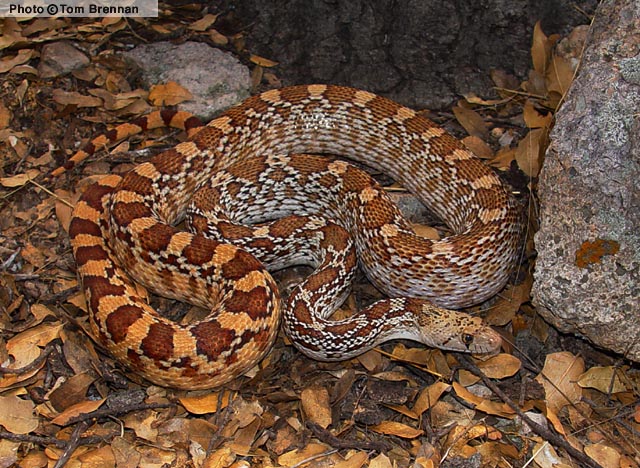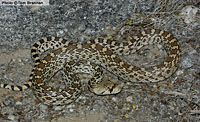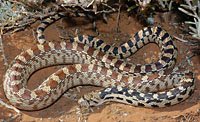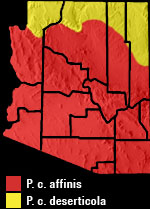Online Field Guide to The Reptiles and Amphibians of Arizona



P. c. affinis, Santa Cruz County, AZ
 P. c. afinis, Maricopa Co., AZ |
| GOPHERSNAKE Pituophis catenifer |
Non-Venomous
|
| DESCRIPTION: Arizona’s longest snake (up to 2,337 mm or 92″ in total length). Base coloration is tan, cream, yellow, orange-brown, or pale gray. A series of large, brown, reddish brown, black, or olive blotches lines the back (dorsal blotches). On the neck and anterior half of the body the large dorsal blotches are surrounded by a busy pattern of interconnected linear patches, dashed striations, and small blotches. This pattern becomes much less busy on the posterior portion of the body where the blotches are more distinct and there are fewer surrounding markings. On the tail the markings become a clean pattern of dark bands on a plain background. The belly is pale or white with small dark blotches. The pupils are round. The dorsal scales are keeled distinguishing this snake from the similar looking Glossy Snake.
DISTRIBUTION: This snake is found in nearly every part of the state. It occurs at elevations ranging from near sea level along the Colorado River to about 9,000′ in our high mountains. It is absent only from our highest peaks. HABITAT: A true generalist, this snake is found in all of Arizona’s biotic communities with the exception of the small tract of treeless Alpine Tundra on the peaks of the San Francisco Mountains in Coconino County. It is most abundant in moderate terrain such as foothills, bajadas, and flatlands below about 6,000′ elevation but it inhabits a wide variety of habitats ranging from hot, dry, low elevation, sand dunes to heavily wooded slopes.BEHAVIOR: The Gophersnake can be active around the clock when conditions are favorable. It hibernates during the cold months of late fall and winter. It is primarily a ground-dweller but is capable of climbing. When threatened it often raises its head and neck into a striking posture, hisses loudly, flattens and broadens the head, and vibrates the tail. When exhibiting this behavior it is often mistaken for a rattlesnake.DIET: This is a powerful constrictor that preys on a wide variety of animals including rats, mice, rabbits, lizards, birds, snakes, eggs, and insects.REPRODUCTION: Mating takes place in spring and a clutch of up to 24 eggs is laid in late spring or early summer. Hatchlings begin to emerge in August.SUBSPECIES FOUND IN AZ: GREAT BASIN GOPHERSNAKE Pituophis catenifer deserticola. This subspecies is found in the northern quarter of the state. Dorsal blotches are usually black on the neck. By Thomas C. Brennan Bartlett. 2000. Snakes of North America: WesternRegion. Gulf Publishing Co. Houston, TX Brennan, T. C., and A. T. Holycross. 2006. A Field Guide to Amphibians and Reptiles in Arizona. Arizona Game and Fish Department. Phoenix, AZ Brennan, T. C., and A. T. Holycross. 2005. A Field Guide to Amphibians and Reptiles of Maricopa County. Arizona Game and Fish Department. Phoenix, AZ Degenhardt, W. G., Painter, C. W., and Price, A. H.. 1996. Amphibians and Reptiles of New Mexico. University of New Mexico Press. Albuquerque. Fowlie. 1965. The Snakes of Arizona. Azul Quinta Press, Fallbrook, CaliforniaStebbins. 1985. Western Reptiles and Amphibians. Houghton Mifflin. New York, |
|
Visit Partners in Amphibian and Reptile Conservation:


HOME
Copyright © 2023, Arizona Game and Fish Department. All rights reserved.
If you make use of the textual contents of this site in reports, publications, etc. please cite and credit the author(s) and photographer(s). All photos on this website are copyrighted. However, those found in the species account section may be used for any noncommercial scientific, educational, or conservation purposes provided that photographs are not altered and continue to bear the copyright symbol and name of the photographer. Please contact the photographer regarding commercial use of copyrighted photographs.











